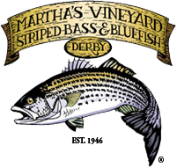Dreams Come True in the 51st Derby
By Nelson SigelmanThe 51st derby began on a dark, damp night that proved to be memorable for many anglers. Along Chappy's East Beach stripers exploded from the black surface of the ocean in a glow of shimmering phosphorescence. On the south shore fishermen watched poles bend under the weight of a solid hit. It was as if the whole fall run had converged on the Island, or, as one angler described it, "It was the night of a thousand bass." The derby weigh station, set up in Oak Bluffs for the first time in many years, was a busy place on the first morning of operation. It began when Chris Scott carried in a 42-inch, 25-pound striped bass when the doors opened. But it was Mark Plante's 47-pound striper, not a particularly big fish by past derby standards, that would prove to be the biggest surprise. Wrestled from the surf in the early hours of the derby, Mark's bass (but not his fingernails) would go the distance. For the first time in derby history, one fish would lead from start to finish.
By the second week of the derby, the larger stripers that had seemed so abundant were just as scarce. The albies were charging Cape Poge gut, offering an opportunity for shore-bound fishermen while boat fishermen chased down every splash. High winds and frequent storms, however, did little to improve the fishing. But the derby has always been special, a tournament built on camaraderie as well as competition. Some fishermen were finding fish, and they adopted an attitude toward their less fortunate fishing friends that continued to reflect the best derby traditions. Which is to say that secrecy, subterfuge, and paranoia were the norm.
The third week of the derby separated the fisherboys from the fishermen; the dilettantes from the truly committed; the serious caster from the truly obsessed. The tougher the fishing, the harder the fishermen pursued the one fish they knew could make all the difference. Spouses with more than a few years of derby fishing experience knew that all the commitments - "Don't worry honey, I'm not going to fish that hard this derby." - were out the window. Bonito in the morning, striped bass at night, blues blitzing Wasque, where to find albies: there was a lot going on out there in derby world. Jan Lepore, wife of "Bonito" Eddy Lepore, summed up the derby's hold one afternoon.
"There is something about the derby," she explained with amusement. "We had a normal friend come over and by the end of two weeks he was no longer normal, he was possessed by the fish."
The fishing during the last week of the derby was tough. False albacore had headed south after one blow too many. Striped bass and bluefish were scarce. And bonito - well, they were around, but they were still bonito. Finding them did not mean you caught them. One exception was young Miles Whyte, who bested his seniors when he boated a 9.45-pound bonito to temporarily take the lead. But four days before the finish of the derby, Perry Ambulos, invited to go fishing with his friend Dave Thompson, put a fly in front of the winning boat bonito off of big bridge.
Gale-force winds blew on Saturday, the last day of the derby. But despite the high winds, heavy seas, and impending torrential rain, derby fishermen still figured they could fish in the lee, even if the wind was gusting past 40 mph. And on the last day of the derby, fishermen were going to play any odds to look for that one big hit. The thought process went something like this: "Well, I know the wind is blowing 380 miles per hour, and the rain is coming sideways, but it's out of the southeast so if I fish the north shore at least I'll be in the lee. I should be able to cast and those bass might be right on the shore. And if I do get a fish it'll take a daily, because who's going to be out today?"





















